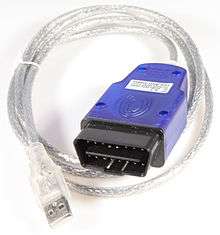Carputer
A carputer is a computer with specializations to run in a car, such as compact size, low power requirement, and some customized components. The actual computing hardware is typically based on standard PCs or mobile devices. Because they are computer based they typically have many standard interfaces such as Bluetooth, USB, and WiFi.[1] The first carputer was introduced by Clarion Co. on December 4, 1998,[2] although on-board diagnostics have already been employed ever since the 1980s in order to measure precisely the amount of fuel entering the engine as the carburetors got too complex.[3]
A challenge to installing a computer in a car is the power supply. Energy is supplied as a nominal 12V DC in cars or 24V in some trucks. The real voltage varies according to whether the engine is on or off since the battery generally delivers less than 12V, while the generator supplies more. There can be peaks, and at ignition time the current supply drops. External DC/DC converters can help to regulate voltages so these can be used.[1]
Police cars often have Mobile data terminals in the form of a laptop swivel mounted where the driver's armrest would be. This can be used to log data and to query networked databases.[4]
Microsoft developed Windows Embedded Automotive and used it with the AutoPC, a brand of carputer jointly developed with Clarion.[5] The system was released in 1998, and referred to the operating system itself as "Auto PC".[6] It was based on Windows CE 2.0.[7] It evolved into "Windows CE for Automotive".[8] The platform was used for the first two generations of MyFord Touch while the third generation runs QNX from BlackBerry Limited.[9][10]
Tablet computers such as the Nexus 7[11] can be installed either permanently (in-dash) or removably (a dock).[12] It can be used for watching movies or listening to music, as well as for GPS navigation. It also has a Bluetooth for hands-free calls.[13]

Computers can be used to decode on-board diagnostics (OBD) data to a visual display. Many interfaces are based on the ELM327 OBD Interpreter ICs. Also STN1110 is known to be used.[14]
See also
References
- 1 2 "Introduction to CarPuters | CARPUTER WORLD | Carputer Products and Accessories". CARPUTER WORLD. Retrieved 2016-01-16.
- ↑ "Automation History – The First Embedded Car PC was introduced on Dec. 4, 1998".
- ↑ Laurens, Eli. "Car Computer History". eHow.
- ↑ "How Police Cars Work". HowStuffWorks. Retrieved 2016-01-17.
- ↑ "Microsoft Announces Auto PC, PC Companion Powered by Windows CE 2.0". Microsoft. 1998-01-08. Retrieved 2014-04-22.
- ↑ "Drivers Keep Hands on Wheel, Eyes on Road, as Auto PC Provides Easy Access to Information and Entertainment". Microsoft. 1998-12-04. Archived from the original on December 4, 2008. Retrieved 2009-05-07.
- ↑ "Microsoft Pioneers Interactive Speech Technology". Microsoft. 1998-01-08. Retrieved 2009-05-07.
- ↑ "Microsoft Windows CE for Automotive 3.5 Advances In-Car Computing" (Press release). Microsoft. 5 December 2001. Retrieved 24 April 2011.
- ↑ Ford dumps Microsoft for Blackberry for Sync 3 USA Today (12/11/2014)
- ↑ Burns, Matt (11 December 2014). "Ford Ditches Microsoft For QNX In Latest In-Vehicle Tech Platform". TechCrunch. Retrieved 3 May 2015.
- ↑ "Nexus 7 makes the best in-car entertainment system ever". Android Central. Retrieved 2016-01-17.
- ↑ "Optimise a tablet for the car - APC". APC. Retrieved 2016-01-17.
- ↑ "How to : Using Android tablet ( or iPad ) as Car PC - multimedia ,internet and calling in car - theGadgetPill". theGadgetPill. Retrieved 2016-01-17.
- ↑ STN1110 specifications